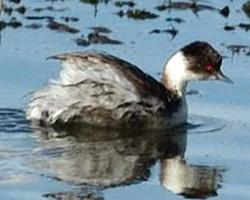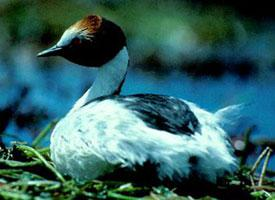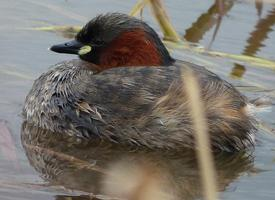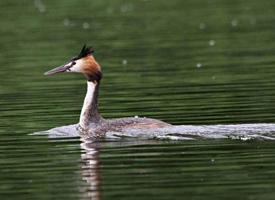
Poids et mesures
| Longueur | de 46 à 51 cm |
|---|---|
| Poids | de 750 à 1200 g |
| Envergure des ailes | de 59 à 73 cm |
Statut de conservation
| Menacé |
Description de l'animal
The Great Crested Grebe (Podiceps cristatus) is a captivating species of waterbird that belongs to the family Podicipedidae. Renowned for its striking appearance and elaborate courtship displays, this bird has captured the interest of birdwatchers and nature enthusiasts around the globe.Characteristically, the Great Crested Grebe is a medium to large-sized bird, measuring between 46 to 51 centimeters in length with a wingspan that spans approximately 59 to 73 centimeters. It possesses a slender, elongated neck and a robust, streamlined body that is superbly adapted for an aquatic lifestyle. The adult grebe's plumage during the breeding season is particularly striking. It showcases a distinctive black double crest on the head, with rufous or chestnut-colored fringes, and an elegant black neck with a white face and throat. The bird's back is dark brown, blending seamlessly into the water, while the underparts are a clean, bright white, providing a stark contrast.
One of the most remarkable aspects of the Great Crested Grebe is its courtship display, a complex and highly choreographed ritual that is a spectacle to behold. Pairs engage in a synchronized ballet, mirroring each other's movements with precision. The display involves a series of gestures, including head shaking, diving, and presenting each other with water plants. This ritual not only strengthens the pair's bond but also establishes their territory.
Great Crested Grebes are predominantly aquatic and are rarely seen on land due to their awkward gait. Their legs are set far back on their bodies, which, while making them clumsy walkers, provides them with powerful propulsion in water. Their feet are lobed, not webbed, aiding in their graceful and efficient underwater pursuit of fish, their primary diet. They also consume insects, small crustaceans, and amphibians.
These birds are excellent divers, capable of disappearing beneath the surface in a blink and re-emerging several meters away. They build floating nests anchored to underwater plants in sheltered locations such as reed beds. Both parents share the responsibility of incubating the eggs and rearing the young, which are often seen riding on the backs of their parents, nestled among the feathers.
The Great Crested Grebe breeds in freshwater lakes and reservoirs across Europe and Asia, with some populations found in Africa and Australasia. They are migratory birds, with many northern populations moving southwards to warmer climates during the winter months. Despite facing threats from habitat destruction, pollution, and entanglement in fishing gear, conservation efforts have helped stabilize their numbers in many areas.
In conclusion, the Great Crested Grebe is a magnificent bird with a remarkable aesthetic and behavioral repertoire. Its adaptability to aquatic environments, striking breeding plumage, and intricate courtship displays make it a fascinating subject for study and observation. Conservation efforts continue to be crucial in ensuring the survival and prosperity of this unique species across its range.
Carte de répartition
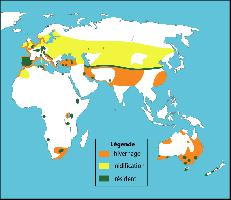
Animaux similaires
Nouvelles photos d'animaux
Top 10 des animaux
- Dolphin gull (Leucophaeus scoresbii)
- Diana monkey (Cercopithecus diana)
- Moustached guenon (Cercopithecus cephus)
- Galápagos tortoise (Geochelone nigra complex)
- Russian tortoise (Testudo horsfieldii)
- Japanese macaque (Macaca fuscata)
- Stone loach (Barbatula barbatula)
- Greek tortoise (Testudo graeca)
- Common flying dragon (Draco volans)
- Colossal squid (Mesonychoteuthis hamiltoni)
